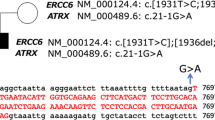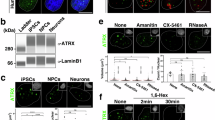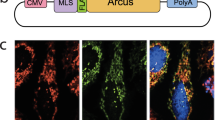Abstract
ATR-X syndrome is a rare syndromic X-linked mental retardation disorder. We report that some of the patients suspected of ATR-X carry large intragenic duplications in the ATRX gene, leading to an absence of ATRX mRNA and of the protein. These findings underscore the need for including quantitative analyses to mutation analysis of the ATRX gene.
Similar content being viewed by others
Log in or create a free account to read this content
Gain free access to this article, as well as selected content from this journal and more on nature.com
or
Accession codes
References
Gibbons R : Alpha thalassaemia-mental retardation X linked. Orphanet J Rare Dis 2006; 1: 15.
Menten B, Maas N, Thienpont B et al: Emerging patterns of cryptic chromosomal imbalances in patients with idiopathic mental retardation and multiple congenital anomalies: a new series of 140 patients and review of the literature. J Med Genet 2006; 43: 625–633.
Bauters M, Van Esch H, Marynen P, Froyen G : X chromosome array-CGH for the identification of novel X-linked mental retardation genes. Eur J Med Genet 2005; 48: 263–275.
Devriendt K, Matthijs G, Legius E et al: Skewed X-chromosome inactivation in female carriers of dyskeratosis congenita. Am J Hum Genet 1997; 60: 581–587.
Vandesompele J, De Preter K, Pattyn F et al: Accurate normalization of real-time quantitative RT-PCR data by geometric averaging of multiple internal control genes. Genome Biol 2002; 3: RESEARCH0034.
McDowell TL, Gibbons RJ, Sutherland H et al: Localization of a putative transcriptional regulator (ATRX) at pericentromeric heterochromatin and the short arms of acrocentric chromosomes. Proc Natl Acad Sci USA 1999; 96: 13983–13988.
Allen RC, Zoghbi HY, Moseley AB, Rosenblatt HM, Belmont JW : Methylation of HpaII and HhaI sites near the polymorphic CAG repeat in the human androgen-receptor gene correlates with X chromosome inactivation. Am J Hum Genet 1992; 51: 1229–1239.
Abidi FE, Cardoso C, Lossi AM et al: Mutation in the 5′ alternatively spliced region of the XNP/ATR-X gene causes Chudley-Lowry syndrome. Eur J Hum Genet 2005; 13: 176–183.
White SJ, Aartsma-Rus A, Flanigan KM et al: Duplications in the DMD gene. Hum Mutat 2006; 27: 938–945.
White S, Kalf M, Liu Q et al: Comprehensive detection of genomic duplications and deletions in the DMD gene, by use of multiplex amplifiable probe hybridization. Am J Hum Genet 2002; 71: 365–374.
Kozlowski P, Roberts P, Dabora S et al: Identification of 54 large deletions/duplications in TSC1 and TSC2 using MLPA, and genotype–phenotype correlations. Hum Genet 2007; 121: 389–400.
Wimmer K, Yao S, Claes K et al: Spectrum of single- and multiexon NF1 copy number changes in a cohort of 1100 unselected NF1 patients. Genes Chromosomes Cancer 2006; 45: 265–276.
Ferec C, Casals T, Chuzhanova N et al: Gross genomic rearrangements involving deletions in the CFTR gene: characterization of six new events from a large cohort of hitherto unidentified cystic fibrosis chromosomes and meta-analysis of the underlying mechanisms. Eur J Hum Genet 2006; 14: 567–576.
Van Esch H, Bauters M, Ignatius J et al: Duplication of the MECP2 region is a frequent cause of severe mental retardation and progressive neurological symptoms in males. Am J Hum Genet 2005; 77: 442–453.
Thienpont B, Gewillig M, Fryns JP, Devriendt K, Vermeesch JR : Molecular cytogenetic characterization of a constitutional complex intrachromosomal 4q rearrangement in a patient with multiple congenital anomalies. Cytogenet Genome Res 2006; 114: 338–341.
Acknowledgements
We thank the families for their kind cooperation, Dr D Garrick (Weatherall Institute of Molecular Medicine, Oxford, UK) and I Cleynen (Department for Human Genetics, Leuven, Belgium) for the generous donation of the antibodies, and Dr F Foulquier for sharing his expertise in protein studies.
Author information
Authors and Affiliations
Corresponding author
Additional information
Supplementary Information accompanies the paper on European Journal of Human Genetics website (http://www.nature.com/ejhg)
Supplementary information
Rights and permissions
About this article
Cite this article
Thienpont, B., de Ravel, T., Van Esch, H. et al. Partial duplications of the ATRX gene cause the ATR-X syndrome. Eur J Hum Genet 15, 1094–1097 (2007). https://doi.org/10.1038/sj.ejhg.5201878
Received:
Revised:
Accepted:
Published:
Issue date:
DOI: https://doi.org/10.1038/sj.ejhg.5201878
Keywords
This article is cited by
-
Integrated omics analyses clarifies ATRX copy number variant of uncertain significance
Journal of Human Genetics (2024)
-
ATR-X syndrome: genetics, clinical spectrum, and management
Human Genetics (2021)
-
625 kb microduplication at Xp22.12 including RPS6KA3 in a child with mild intellectual disability
Journal of Human Genetics (2015)
-
The role of genetics in the establishment and maintenance of the epigenome
Cellular and Molecular Life Sciences (2013)
-
The first large duplication of the RSK2 gene identified in a Coffin-Lowry syndrome patient
Human Genetics (2007)



